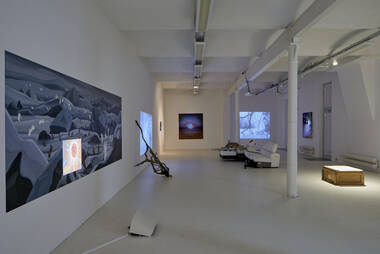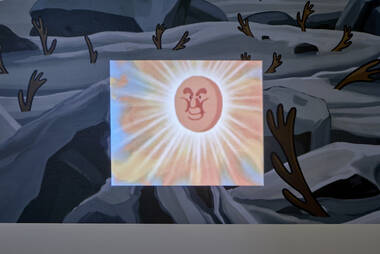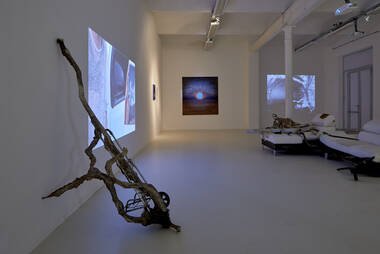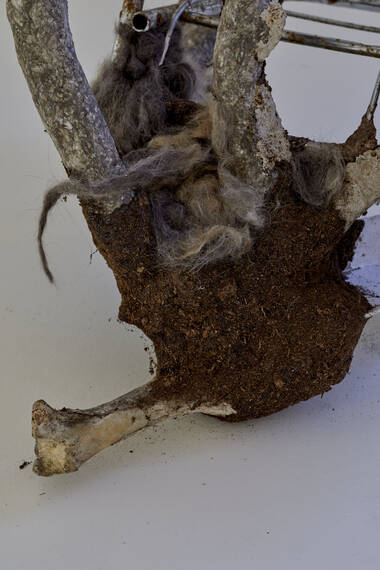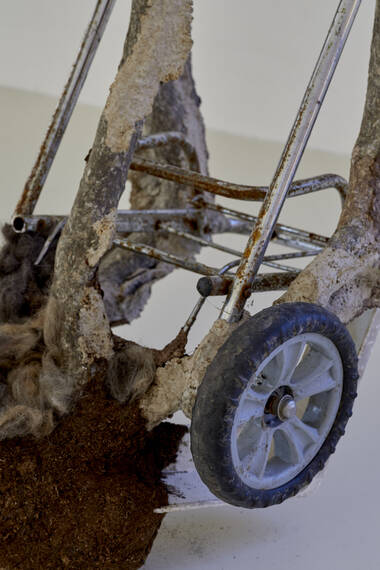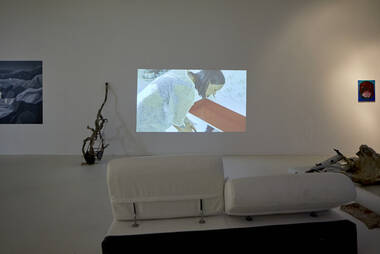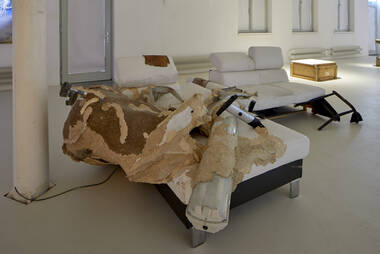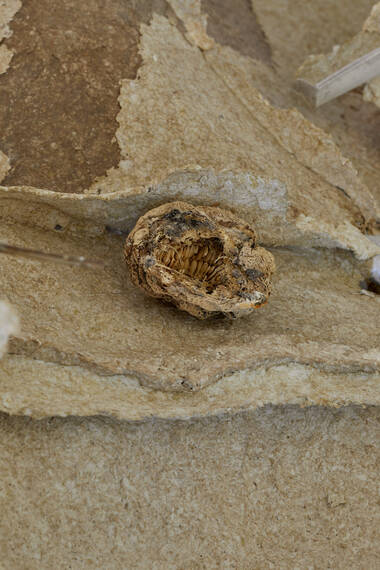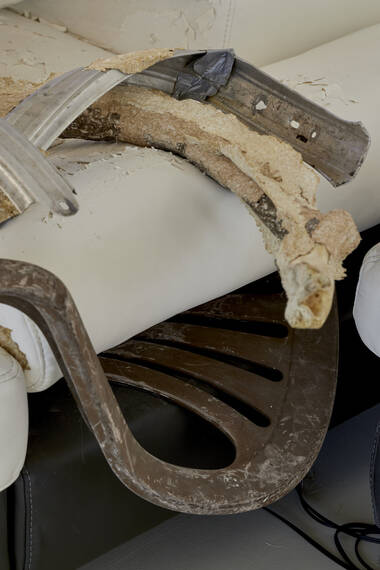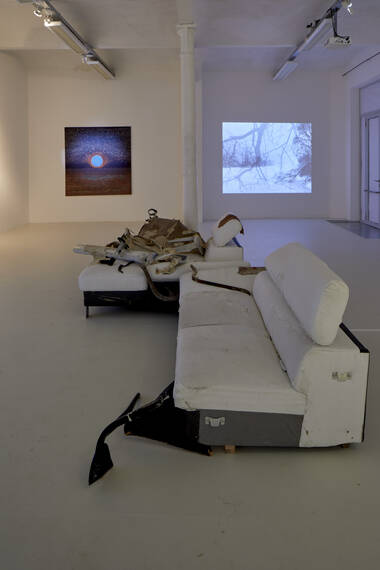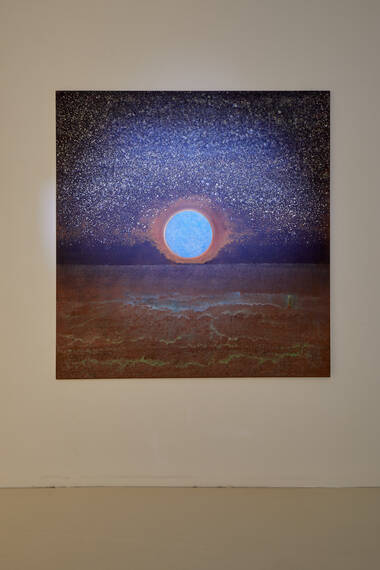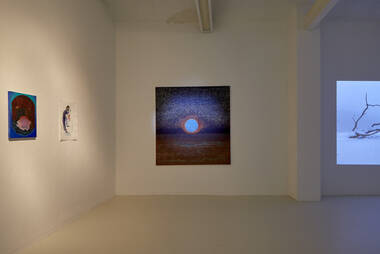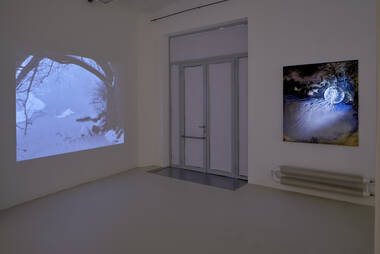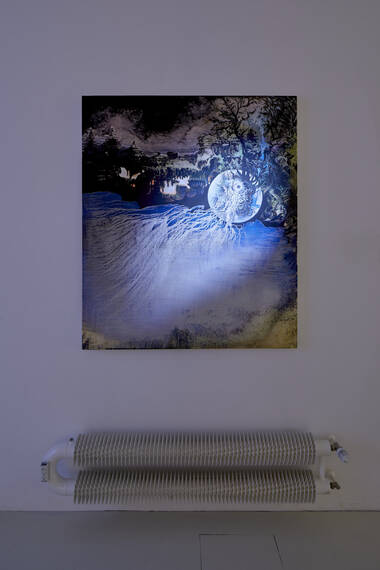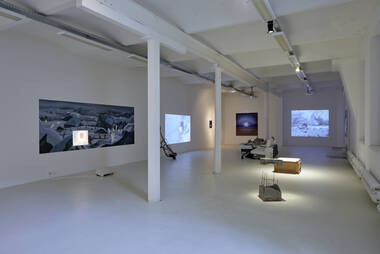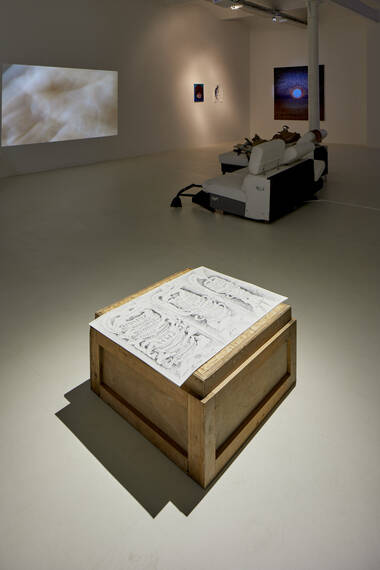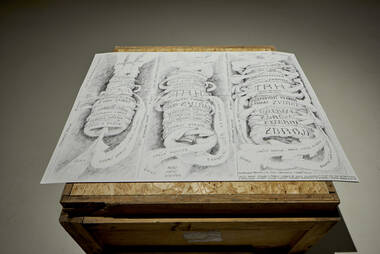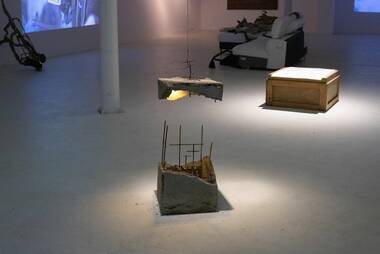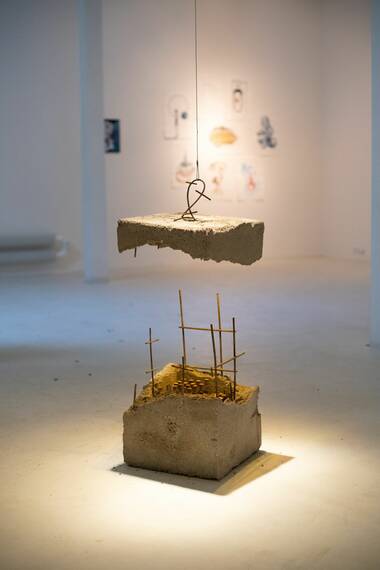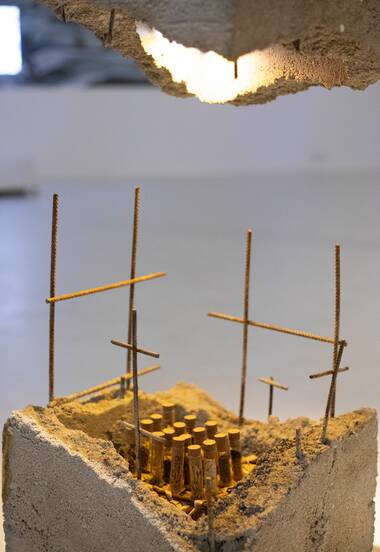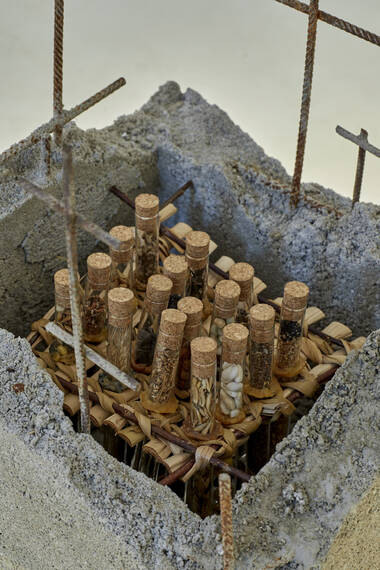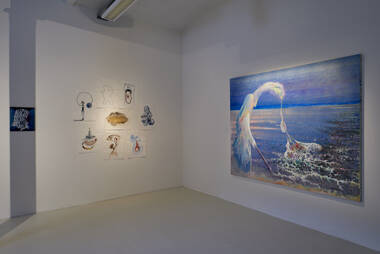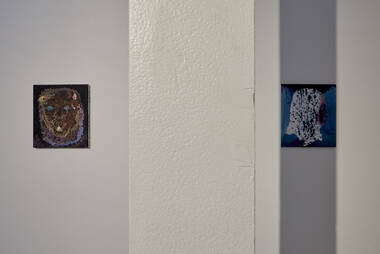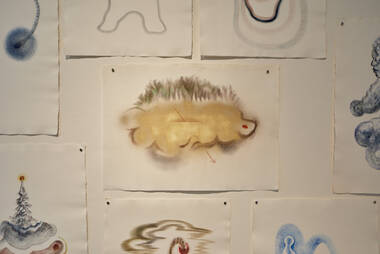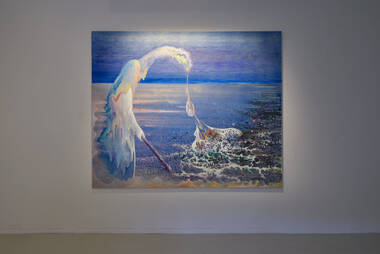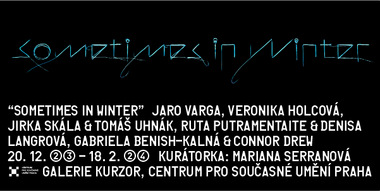Sometimes in Winter
opening: 19. 12. 2023 from 6 pm
20. 12. 2023 – 18. 2. 2024
artists: Jaro Varga, Veronika Holcová, Jirka Skála / Tomáš Uhnák, Ruta Putramentaite / Denisa Langrová, Gabriela Benish-Kalná / Connor Drew
curator: Mariana Serranová
art clooboration: Jan Brož
technical collaboration: Pavel Havrda
I. Sometimes in winter
At the waning of the century,
with the weather warming,
and even seasons losing their way.
Linda Pastan, December 18: For M (Poetry, December 1990)1
“Winter temperatures overall are still expected to be above average, with varying degrees of deviation from the norm. Some models indicate temperatures will be well above average, others only slightly. This is based on the assumption that winds will tend to be west to south-westerly. Periods of cold air cannot be ruled out, one of which we are experiencing even before the onset of winter.”2
(Outlook for winter 2023/2024, Meteoaktuality, 5 December 2023)
Out of the blue comes a storm.
A storm means a flooded basement.
After a dry year, expect another dry year.
Little rain, an empty barn.
The deeper the well, the less water.
Mud before Christmas, mud after Christmas.
Radek Štěpánek, From The New Weather Lores (2023)3
Two months ago, no one could have predicted the snow storms that swept across Europe in early December. Some meteorologists were of the opinion that we would not experience much snow this year. Conflicting weather trends. When experts hazard a long-range forecast, they speculate, they inhabit the realm of assumptions, they predict this and that and appeal to new trends as much as to experience. The consensus is that this year’s record warm autumn confirms the ongoing fact of climate warming and heralds a “new normal”. The outlook is apparently warm and changeable for winter too.4 However, at the same time, the atmospheric phenomenon known as El Niño has begun to affect the climate of Europe and North America and may in turn bring cooler weather. Yet other sources deny this. And will there be less snow or more? It is also said that after a warm winter comes a cool spring. We’ll see. Let’s see winter out before dealing with spring.
Predicting the future is not much easier in the realm of politics. At the start of the cycle Seasons it seemed that the post-Covid fatigue, inflation, the energy crisis and the war still being fought in Ukraine were stressors that were afflicting our collective mood far more than the delayed spring and the uncertainty brought on by the long-term global warming trend. Despite all the scepticism of analysts, we had high hopes in the run-up to spring this year that the protracted war between Ukraine and Russia would end. It has not. Then out of the blue came the events in the Middle East, which no one expected and added to the sense of shock. No one wanted to believe that the long-standing power asymmetries and injustices that politically divide the world would take on such a terrifying and vindictive intensity and degenerate into such an intolerable human tragedy. It is difficult to say what next year will bring. No one is betting on the vitally important unknowns: they are simply hoping that the current armed aggression will end and that there will be no pandemic, no fires, and no devastating floods and earthquakes.
II. New winter backdrop
Our life
is like ski tracks
in the white expanse:
swept away by the snowstorm
at early dawn.
Paulus Utsi, Giela Gielain (1980)5
the sharp tips of spruces
it’s not snow
just bare wood
at a height
at which the wind has swept
like a giant spinning snowflake
was last year a waste of time?
the skier was almost hit
by a falling drone
(…)
We don’t remember
how many seasons this winter has to last?
Oh, ages
I’m sorry?
Ages
When we want summer, we travel
just like spring
and there are people who want just for a while to exchange winter
for autumn’s departure and forgiving
to prepare again, this time more carefully
Katarína Kucbelová, k bielej (2022)6
Winter kept us warm, covering
Earth in forgetful snow, feeding
A little life with dried tubers.
(…)
I read, much of the night, and go south in the winter.
T. S. Eliot, The Waste Land (1922)
One of the bucolic charms of Nordic painting was to situate hunting scenes and sporting or social activities against the white background of a snowy landscape. The sparkling mood of ice skaters is not yet rare in our region of the world, it is simply that the overall context appears somewhat different during a time of climate change. Winter revelry and the celebration of abundance has transmogrified into a few months of Christmas consumerism, with residents of privileged parts of the globe travelling en masse to mountain resorts or warmer climes for sport, while life becomes more complicated for traditional ethnic groups on the periphery of global economic concerns. According to the Laplanders, the Nordic winter has been harsher in the despoiled taiga over the last ten years. Snow has given way to rain and vegetation is freezing. Herders have to help the weakened reindeer with food, cutting lichen and leading them to garages to warm up. Lapland’s problems are similar to many other marginalised zones around the planet, where exploitation of the landscape goes hand in hand with colonisation of minority groups. They have not made peace with their own history, because it keeps repeating itself, the tactics of colonisation simply take on new forms.
Reflections upon these constitutive relationships formed by power for immediate profit, something which is in fatal conflict with the health of society and life on the planet in general, are the subject of just about all ecologically oriented texts. Contemporary eco-Marxists, for instance, track the relevance of Marx’s social concept of “metabolic rift”, which they apply in a broader sense to the current ecological crisis. Natural cycles have irreparably lost their balance. A case in point would be the metabolism of carbon, the collapse of which could have disastrous consequences involving agriculture problems, soil depletion, overproduction and issues with waste. This is but a fraction of the biosocial organism.
The psychology of climate change is a chapter in itself and the scholarly texts are beginning to pile up. The impacts on the physical health of biological subjects and the more vulnerable societies that suffer from chronic drought, toxicity, tornadoes and human destruction are plain to see: we are counting human lives. However, the long-term stress or trauma of natural and anthropogenic catastrophes may also be related to the fact that a wide range of long-term, sudden problems are involved. The situation is not improving, which is why the issue of what we actually define as extreme remains open to debate.
III. Dreams and nightmares come true
I can taste the tin of the sky — the real tin thing.
Winter dawn is the color of metal,
The trees stiffen into place like burnt nerves.
All night I have dreamed of destruction, annihilations.
Sylvia Plath, Waking in Winter (1960)
London a tower of nightmares.
New York a psychiatric clinic.
Tokyo a slave market.
Los Angeles a haunted city.
Kalamazoo in the state of Michigan
one of the first American cities
where they closed the streets to cars for a pedestrian mall.
Nanao Sakaki, From Around the World (1979)
Every day I search for positive news among the headlines to offset the prevailing bad news and avoid nightmares. Here’s a snippet of good news: while not a tonic, things feel a little better. Someone has clearly articulated a problem, something bad has passed, someone has found a cure and something elsewhere has finally changed. Normal people do, in fact, exist. But then there is the good fortune to live in a country whose climate is thus far compatible with life. We move on, without such basic gratitude there is no gratification.
The problems of politics and ecology may be daunting, but we cannot overlook the plight and long-term stress and/or trauma of survivors of natural and anthropogenic disasters either. The suffering we see in the media is not okay. The twists and turns of long-term and sudden crises is a space for resignation, blockage and catastrophic fantasies: we call this doomscrolling. Is it any wonder that as the situation is objectively deteriorating we continue to feel that the extreme has not yet arrived? We cannot predict what the future of the planet will look like, but there is room for a degree of responsibility. Perhaps this is at least partial responsibility for our own psychological states.
In contemporary fiction, art, and in everyday daydreaming and sharing, we observe many dark visions that are reflections of the current state of affairs. They are legitimate, cautionary, and sometimes just one small step away from constructive measures. The project Seasons was intended to create a platform for the free expression of contemporary artists in the simplest and most natural way. Their works were not supposed to reflect the stereotypical moods of each individual season, but to create new relationships in the shared space-time of joint exhibitions, without these artists straying from their unique creative focus. Their work traces the timeless relationships between society and nature, politics and art, capturing the specific mood that characterises the most current sensibility. It gives us the chance to see that there have been similar existential states and crises in the past and that life has carried on. Perhaps.
1www.poetryfoundation.org/search
2www.pocasimeteoaktuality.cz/vyhled-na-zimu-2023-2024/
3Radek Štěpánek, Hezké počasí. Brno 2023, p. 9.
4www.seznamzpravy.cz/clanek/domaci-zivot-v-cesku-teply-podzim-vesti-novy-normal-prijdou-exoticke-nemoci-i-pole-jako-z-francie-238956
5swedishbookreview.org/inifran-sapmi-vittnesmal-fran-stulet-land-review
6 Katarína Kucbelová, k bielej. Skalná ruža, 2022.
The program of the Cursor Gallery is possible through kind support of Ministry of Culture of the Czech Republic, Prague City Council, State Fund of Culture of the Czech Republic, City District Prague 7,
GESTOR – The Union for the Protection of Authorship
Media partners: ArtMap, jlbjlt.net and artalk.cz
Thanks: Pavel Havrda
